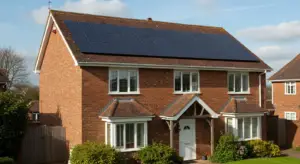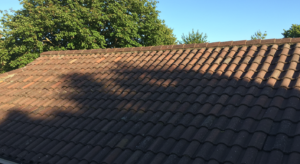Is My Roof Suitable for Solar Panels in Terms of Size and Orientation?

Considering solar panels for your home in Hampshire, Dorset, or Wiltshire is a significant step towards energy independence and reduced electricity bills. A primary question homeowners ask is: “Is my roof suitable for solar panels?”. Several factors determine your roof’s compatibility with a solar panel system, primarily its size, orientation, pitch, condition, and freedom from shading. Getting this right is crucial for maximising your investment and ensuring efficient energy generation for years to come. Let Starks Solar guide you through the essential considerations.
The Critical Role of Roof Orientation
Orientation refers to the direction your roof slope faces. In the UK, the path of the sun moves across the southern part of the sky. Therefore, the ideal orientation for solar panels is south-facing. A south-facing roof captures the maximum amount of sunlight throughout the day, leading to the highest potential energy generation.
However, south-facing is not the only viable option. East and west-facing roofs can also be very effective locations for a solar panel installation.
- South-Facing: Optimal for maximum daily energy production. Captures strong sunlight from mid-morning to mid-afternoon.
- East-Facing: Captures strong morning sunlight. Good for households with higher energy usage earlier in the day. Can generate roughly 15-20% less energy annually than a south-facing roof.
- West-Facing: Captures strong afternoon and evening sunlight. Ideal for homes with higher energy consumption later in the day, perhaps when returning from work. Also generates approximately 15-20% less energy annually than south-facing.
- East/West Split: Some homes have roof planes facing both east and west. Installing panels on both can provide good energy generation throughout the day, covering both morning and afternoon peaks. This configuration often aligns well with daily energy usage patterns.
- North-Facing: Generally considered unsuitable in the UK. North-facing roofs receive very little direct sunlight, significantly reducing the potential energy generation and making the investment less financially viable. While panels *could* technically be installed, the output would be minimal.
To determine if your roof is suitable for solar panels regarding size and orientation, consider if you have a significant, largely unshaded area facing generally south, east, or west. South-facing roofs in the UK receive the most sunlight, but east and west can still be viable. Remember, accurate orientation assessment is key. Tools like compass apps on smartphones or online mapping services can give you a general idea, but a professional survey provides precise measurements.
How Much Roof Space Do You Need? (Size Matters)

The physical size of your available roof area directly dictates how many solar panels can be installed, which in turn determines the total power output (measured in kilowatts peak, kWp) of your system. More panels mean more potential energy generation.
Consider these points regarding roof size:
- Typical Panel Size: Modern residential solar panels are roughly 1.7 to 1.8 metres tall and about 1.0 to 1.1 metres wide. Their exact dimensions vary slightly by manufacturer and model.
- Space per Panel: Each panel requires approximately 1.8 to 2.0 square metres of roof space, including small gaps needed for mounting clamps and wiring.
- Typical System Size: A common domestic system size in the UK is around 4 kWp. This typically requires 10-12 panels and needs about 20-24 square metres of suitable, unshaded roof space. Larger systems (e.g., 6 kWp) will naturally require more space (around 30-36 square metres).
- Minimum Requirement: While even a small system can provide benefits, most installers recommend having enough space for at least 6 panels (around 12 square metres) to make the installation worthwhile financially and practically.
- Roof Shape and Obstructions: It’s not just about total area. The *usable* area is what counts. Complex roof shapes, dormer windows, skylights, vents, and chimneys reduce the available space for uninterrupted panel arrays. A simple, large rectangular roof plane is ideal.
Calculating the exact usable space requires careful measurement, considering safety margins around the roof edges and any obstructions. This is a standard part of a professional site survey.
The Impact of Shading

Shading is one of the biggest enemies of solar panel efficiency. Even small amounts of shade on a part of a single panel can significantly reduce the output of the entire system, especially with traditional “string” inverter setups.
Sources of shading include:
- Trees: Nearby trees, especially tall ones to the south, east, or west, can cast long shadows, particularly during winter months when the sun is lower.
- Chimneys: Chimney stacks on your own roof can shade adjacent panels as the sun moves across the sky.
- Other Buildings: Neighbouring houses or extensions can block sunlight, especially if they are tall or close by.
- Dormer Windows/Skylights: These roof features can cast shadows and also reduce the available mounting area.
- Satellite Dishes/Aerials: Smaller obstructions, but they still need to be accounted for.
Obstructions like chimneys, dormer windows, or nearby trees causing substantial shade throughout the day will reduce suitability. Shading analysis is a crucial part of a site survey. Installers use specialist tools and software to model the sun’s path throughout the year and predict the impact of any potential shading on system performance.
If shading is unavoidable, solutions like microinverters or power optimisers can help mitigate losses. Unlike traditional string inverters where shade on one panel affects the whole string, these technologies allow each panel to operate independently. This maximises output from the unshaded panels. Discussing shading issues with your installer is vital for designing an effective system. Assessing the environmental impact of going solar includes optimising for minimal shading to maximise clean energy production.
Understanding Roof Pitch (Angle)
The pitch, or angle, of your roof also influences how much sunlight the panels capture. Solar panels are most efficient when sunlight hits them perpendicularly (at a 90-degree angle). Since the sun’s height in the sky changes throughout the day and year, there’s an optimal average pitch.
In the UK (latitude around 50-55 degrees North), the ideal roof pitch for year-round solar generation is typically between 30 and 40 degrees from the horizontal.
- Ideal Pitch (30-40 degrees): Most UK homes fall within or close to this range, making standard “on-roof” mounting systems suitable without significant efficiency loss.
- Shallower Pitch (Less than 30 degrees): Panels might be slightly less efficient, especially in winter when the sun is lower. They may also require more frequent cleaning as rainwater might not run off as effectively.
- Steeper Pitch (More than 40 degrees): Can be slightly less efficient in summer when the sun is high but may perform better in winter. Installation can sometimes be more complex on very steep roofs.
- Flat Roofs (0-10 degrees): Panels cannot be laid flat as they need an angle for efficiency and water runoff. Specialised mounting frames (like A-frames or consoles) are used to tilt the panels to an optimal angle (usually 10-30 degrees). This requires careful consideration of wind loading and roof membrane integrity.
While the ideal pitch maximises generation, deviations don’t necessarily make your roof unsuitable. Modern panels are highly efficient, and the difference in output between a 30-degree and a 20-degree or 50-degree pitch is often less significant than factors like shading or orientation. Your installer will factor the pitch into performance estimates.
Roof Structure, Condition, and Material
Beyond geometry, the physical state of your roof is paramount. Solar panel systems add weight and require secure anchoring.
- Structural Integrity: Your roof structure (rafters, trusses) must be strong enough to support the additional load of the panels and mounting system. This is typically around 15-20 kg per square metre. Most modern roofs are built to withstand much greater loads (like snow), but older properties or those with known structural issues require careful assessment. A qualified installer or structural engineer can verify this.
- Roof Condition and Age: Solar panels have a lifespan of 25 years or more. If your roof covering (tiles, slate) is nearing the end of its life, it’s highly recommended to undertake repairs or replacement *before* installing solar panels. Removing and reinstalling panels later to fix the roof is expensive and disruptive. Check for loose or broken tiles, damaged felt, or signs of leaks.
- Roof Material: Different roof materials require different mounting techniques.
- Concrete/Clay Tiles: Most common. Mounting involves attaching hooks to the roof rafters beneath the tiles and sealing penetrations carefully.
- Slate Tiles: Requires experienced installers as slate is fragile. Specialised hooks and flashing kits are used to prevent breakage and ensure watertightness.
- Metal Roofs (Standing Seam): Often simpler as clamps can attach directly to the seams without roof penetration.
- Flat Roofs (Felt, EPDM, Fibreglass): Typically use ballasted systems (held down by weights) or frames attached to the roof structure, requiring careful waterproofing.
- Asbestos:** If your roof contains asbestos (common in older garages or corrugated roofs), solar panels cannot usually be installed without specialist asbestos removal first, which is a significant additional cost and requires certified professionals. The Health and Safety Executive (HSE) provides guidance on asbestos management.
Planning Permission and Regulations
In most cases, installing solar panels on a residential roof in the UK is considered ‘permitted development’, meaning you don’t need formal planning permission. However, there are important exceptions and conditions:
- Conservation Areas/World Heritage Sites: Stricter rules apply. Panels should not be installed on a roof slope visible from a main road if possible. You may need permission.
- Listed Buildings: You will almost certainly need Listed Building Consent before making any alterations, including solar panel installation.
- Protrusion Limits: Panels should not protrude more than 200mm (20cm) from the roof surface (tiles or slate) or more than 1 metre from a flat roof surface when mounted on a frame.
- Height Limits: Panels should not go higher than the highest part of the existing roof (excluding chimneys).
- Wall Mounts: Rules also apply to wall-mounted panels.
- Safety and Standards: All installations must be carried out safely and comply with building regulations and electrical standards. Using an MCS certified installer like Starks Solar ensures compliance.
It’s always wise to double-check the specific rules with your local planning authority, especially if you live in a designated area or listed building. You can easily check your local council website for guidance. Starks Solar can also advise you on likely requirements during our survey.
The Definitive Answer: A Professional Site Survey
While you can get a general idea using the factors above, the only way to know for sure if your roof is suitable and what size system it can support is through a detailed site survey by a qualified solar professional.
Ultimately, a professional solar installer can provide a precise assessment based on your specific roof dimensions and orientation. Here at Starks Solar, we offer FREE Site Surveys across Hampshire, Dorset, and Wiltshire. During our survey, we will:
- Accurately measure your roof dimensions and usable space.
- Determine the precise orientation and pitch of your roof slopes.
- Conduct a thorough shading analysis using specialist equipment.
- Assess the condition and structural integrity of your roof.
- Discuss your current electricity usage and energy goals.
- Check your existing electrical setup (consumer unit, metering).
- Answer any questions you have about the technology, installation process, and potential savings.
Based on this comprehensive assessment, we can design a bespoke system for your needs. This includes taking your roof space and electricity usage into account to recommend the optimal number of panels, the best inverter technology (string, microinverters, or optimisers), and whether adding a battery storage installation would be beneficial for you. We provide a clear quotation with performance estimates and potential return on investment, drawing on resources like the Energy Saving Trust for guidance on potential savings.
Ready to Find Out About Your Roof?
Determining if your roof is suitable is the first essential step on your solar journey. Considering orientation, size, shading, pitch, and condition provides a solid foundation. While south-facing, large, unshaded roofs are ideal, modern technology means many other roofs in Hampshire, Dorset, and Wiltshire are also perfectly capable of generating significant amounts of clean, free electricity.
Don’t guess – get the facts. Contact Starks Solar today to book your FREE, no-obligation site survey. Let our expert team provide you with a detailed assessment and a tailored proposal to help you harness the power of the sun.

[bookly-form category_id=”1″ service_id=”1″]
Or call us on 01425 460419
Starks Solar Ltd – Your Trusted Solar Partner in Hampshire, Dorset & Wiltshire.
